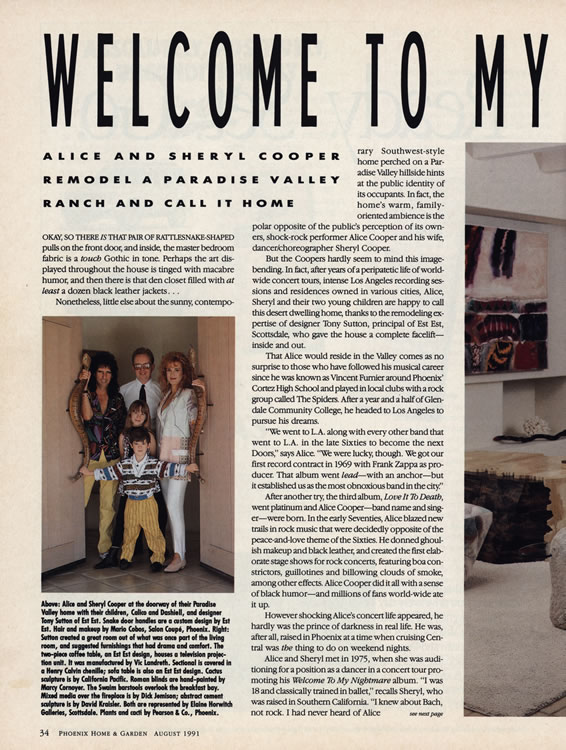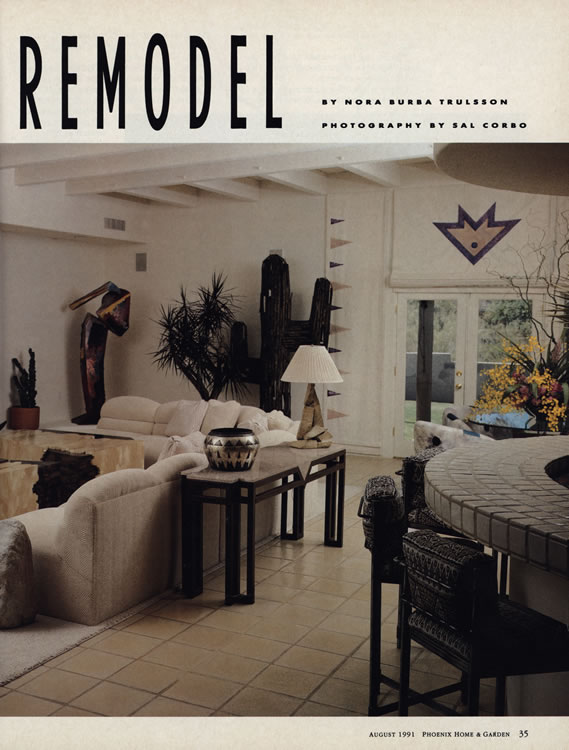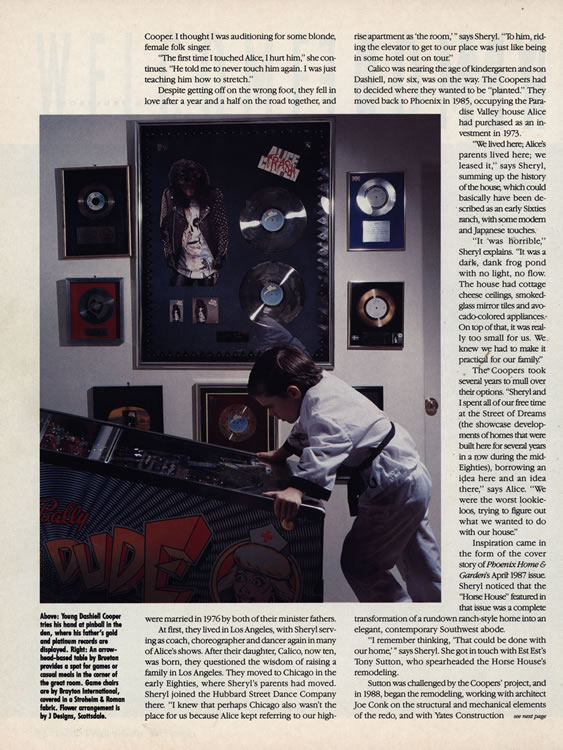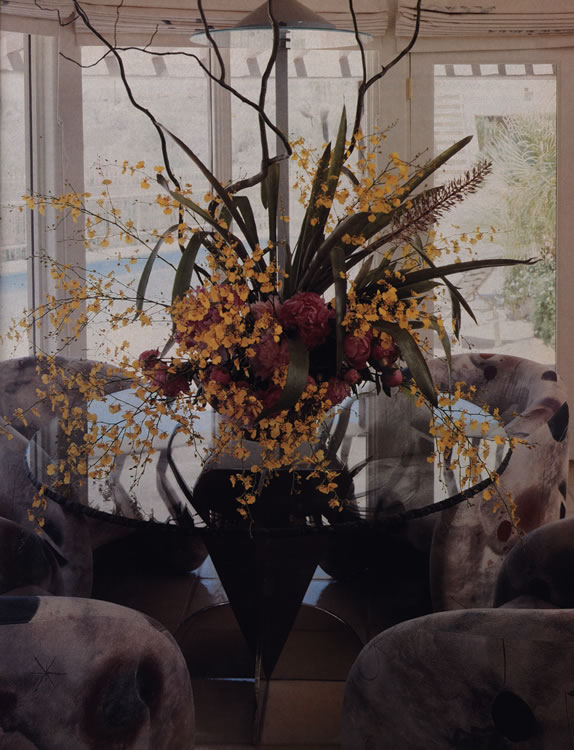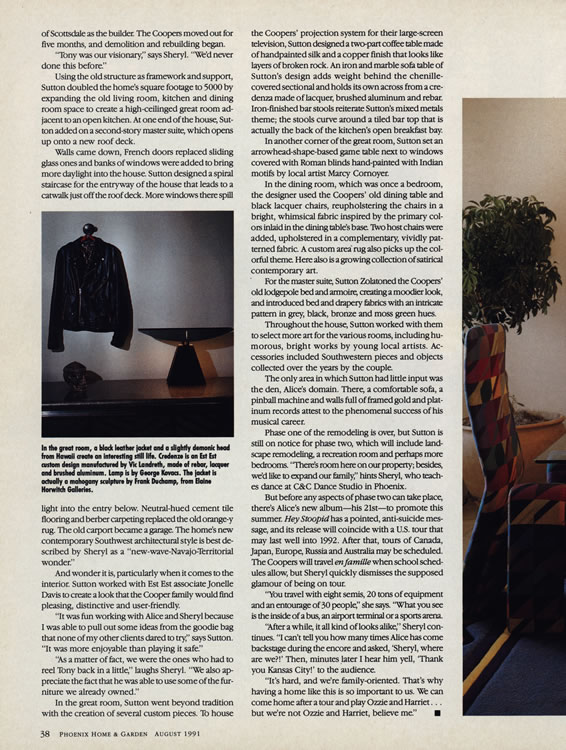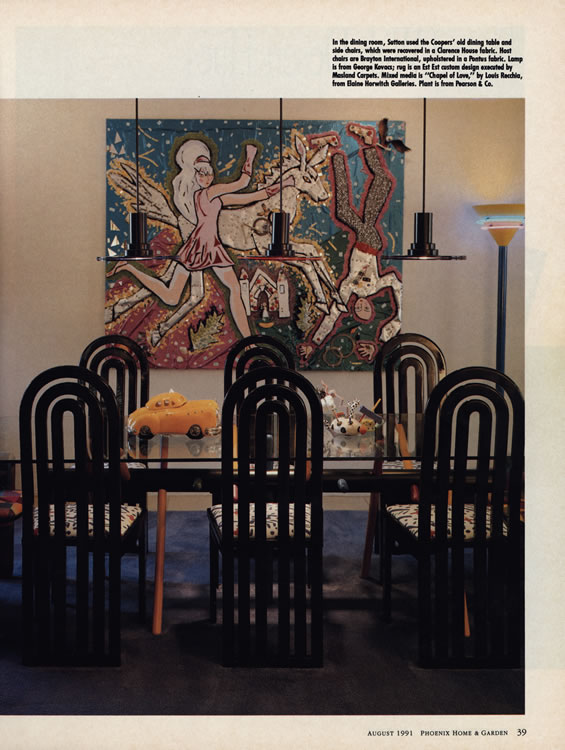Article Database
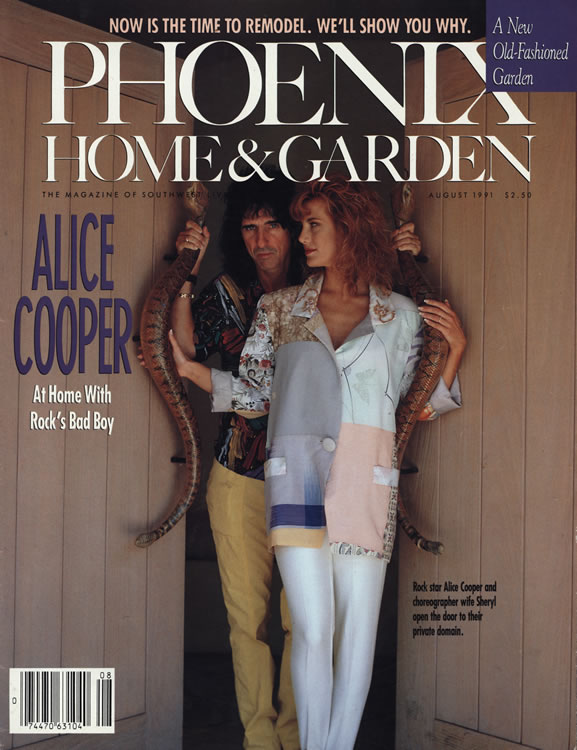
Phoenix Home and Garden
August 1991
Welcome To My Remodel
Alice and Sheryl Cooper remodel a Paradise Valley ranch and call it home
Okay, so there is that pair of rattlesnake-shaped pulls on the front door, and inside, the master bedroom fabric is a touch Gothic in tone. Perhaps the art display throughout the house is tinged with macabre humour, and then there is that den closet filled with at least a dozen black leather jackets...
Nonetheless, little else about the sunny, contemporary Southwest-style home perched on a Paradise Valley hillside hints at the public identity of its occupants. In fact, the home's warm, family-oriented ambience is the polar opposite of the public's perception of its owners, shock-rock performer Alice Cooper and his wife, dancer/choreographer Sheryl Cooper.
But the Coopers hardly seem to mind this image-bending. In fact, after years of a peripatetic life of world-wide concert tours, intense Los Angeles recording sessions and residences owned in various cities. Alice, Sheryl and their two young children are happy to call this desert dwelling home, thanks to the remodelling expertise of designer Tony Sutton, principal of Est Est, Scottsdale, who gave the house a complete facelift - inside and out.
That Alice would reside in the Valley comes as no surprise to those who have followed his musical career since he was known as Vincent Furnier around Phoenix' Cortez High School and played in local clubs with a rock group called The Spiders. After a year and a half of Glendale Community College, he headed to Los Angeles to pursue his dreams.
"We went to L.A. along with every other band that went to L.A. in the late Sixties to become the next Doors," says Alice. "We were lucky, though. We got our first record contract in 1969 with Frank Zappa as producer. That album went lead - with an anchor - but it established us as the most obnoxious band in the city."
After another try, the third album, Love It To Death went platinum and Alice Cooper - band name and singer - were born. In the early Seventies Alice blazed new trails in rock music that were decidedly opposite of the peace-and-love theme of the Sixties. He donned ghoulish makeup and black leather, and created the first elaborate stage shows for rock concerts, featuring boa constrictors, guillotines and billowing clouds of smoke, among other effects. Alice Cooper did it all with a sense of black humour - and millions of fans world-wide ate it up.
However shocking Alice's concert life appeared, he hardly was the prince of darkness in real life. He was, after all, raised in Phoenix at a time when cruising Central was the thing to do on weekend nights.
Alice and Sheryl met in 1975, when she was auditioning for a position as a dancer in a concert tour promoting his Welcome To My Nightmare album. "I was 18 and classical trained in ballet," recalls Sheryl, who was raised in Southern California. "I knew about Bach, not rock. I had never heard of Alice Cooper. I thought I was auditioning for some blond, female folk singer.
"The first time I touched Alice, I hurt him," she continues. "He told me to never touch him again. I was just teaching him how to stretch."
Despite getting off on the wrong foot, they fell in love after a year and a half on the road together, and were married in 1976 by both their minister fathers.
At first, they lived in Los Angeles, with Sheryl serving as coach, choreographer and dancer again in many of Alice's shows. After their daughter, Calico, now ten, was born, they questioned the wisdom of raising a family in Los Angeles. They moved to Chicago in the early Eighties, where Sheryl's parents had moved. Sheryl joined the Hubbard Street Dance Company there. "I knew that perhaps Chicago also wasn't the place for us because Alice kept referring to our high-rise apartment as 'the room'," says Sheryl. "To him, riding the elevator to get to our place was just like being in some hotel out on tour."
Calico was nearing the age of kindergarten and son, Dashiell, now six, was on the way. The Coopers had to decide where they wanted to be "planted." They moved back to Phoenix in 1985, occupying the Paradise Valley house Alice had purchased as an investment in 1973.
"We lived here; Alice's parents lived here; we leased it," says Sheryl, summing up the history of the house, which could basically have been described as an early Sixties ranch, with some modern and Japanese touches.
"It was horrible," Sheryl explains. "It was a dark, dank frog pond with no light, no flow. The house had cottage cheese ceilings, smoked-glass mirror tiles and avocado-colored appliances. On top of that, it was really too small for us. We knew we had to make it practical for our family."
The Coopers took several years to mull over their options. "Sheryl and I spent all of our free time at the Street of Dreams (the showcase development of homes that were built here for several years in a row during the mid-Eighties), borrowing an idea here and an idea there," says Alice. "We were the worst lookie-loos, trying to figure out what we wanted to do with our house."
Inspiration came in the form of the cover story of Phoenix Home & Garden's April 1987 issue. Sheryl noticed that the "Horse House" feature in that issue was a complete transformation of a rundown ranch-style home into an elegant, contemporary Southwest abode.
"I remember thinking, 'That could be done with our home,' " says Sheryl. She got in touch with Est Est's Tony Sutton, who spearheaded the Horse House's remodelling.
Sutton was challenged by the Coopers' project, and in 1988, began remodelling, working with architect Joe Conk on the structural and mechanical elements of the redo, and with Yates Construction of Scottsdale as the builder. The Coopers moved out for five months, and demolition and rebuilding began.
"Tony was our visionary," says Sheryl. "We'd never done this before."
Using the old structure as a framework and support, Sutton doubled the home's square footage to 5000 by expanding the old living room, kitchen and dining room space to create a high-ceilinged great room adjacent to an open kitchen. At one end of the house, Sutton added on a second-story master suite, which opens up onto a new roof deck.
Walls came down, French doors replaced sliding glass ones and banks of windows were added to bring more daylight into the house. Sutton designed a spiral staircase for the entryway of the house that leads to a catwalk just off the roof deck. More windows there spill light into the entry below. Neutral-hued cement tile flooring and berber carpeting replaced the old orange-y rug. The old carport became a garage. The home's new contemporary Southwest architectural style is best described by Sheryl as a "new-wave-Navajo-Territorial wonder."
And wonder it is, particularly when it comes to the interior. Sutton worked with Est Est associate Jonelle Davis to create a look that the Cooper family would find pleasing, distinctive and user-friendly.
"It was fun working with Alice and Sheryl because I was able to pull out some ideas from the goodie bag that none of my other clients dared to try," says Sutton. "It was more enjoyable than playing it safe."
"As a matter of fact, we were the ones who had to reel Tony back in a little," says Sheryl. "We also appreciate the fact that he was able to use some of the furniture we already owned."
In the great room, Sutton went beyond tradition with the creation of several custom pieces. To house the Coopers' projection system for their large screen television, Sutton designed a two-part coffee table made of hand-painted silk and a copper finish that looks like layers of broken rock. An iron and marble sofa table of Sutton's design adds weight behind the chenille-covered sectional and holds its own across from a credenza made of lacquer, brushed aluminium and rebar. Iron-finished bar stools reiterate Sutton's mixed metals theme; the stools curve around a tiled bar top that is actually the back of the kitchen's open breakfast bay.
In another corner of the great room, Sutton set an arrowhead-shaped-based game table next to the windows covered with Roman blinds hand-painted with Indian motifs by local artist Marcy Cornoyer.
In the dining room, which was once a bedroom, the designer used the Coopers' old dining table and black lacquer chairs, reupholstering the chairs in a bright, whimsical fabric inspired by the primary colors inlaid in the dining table's base. Two host chairs were added, upholstered in a contemporary, vividly patterned fabric. A custom area rug also picks up the colorful theme. Here also is a growing collection of satirical contemporary art.
For the master suite, Sutton Zolatoned the Coopers' old lodgepole bed and armoire, creating a moodier look, and introducing bed and drapery fabrics with an intricate pattern in grey, black, bronze and moss green hues.
Throughout the house, Sutton worked with them to select more art for the various rooms, including humorous, bright works by young local artists. Accessories included South-western pieces and objects collected over the years by the couple.
The only area in which Sutton had little input was the den, Alice's domain. There, a comfortable sofa, a pinball machine and walls full of framed gold and platinum records attest to the phenomenal success of his musical career.
Phase one of the remodelling is over, but Sutton is still on notice for phase two, which will include landscape remodelling, a recreation room and perhaps more bedrooms. "There's room here on our property; besides, we'd like to expand our family," hints Sheryl, who teaches dance at C&C Dance Studio in Phoenix.
But before any aspects of phase two can take place, there's Alice's new album - his 21st - to promote this summer. Hey Stoopid has a pointed, anti-suicide message, and its release will coincide with a U.S. tour that may last well into 1992. After that, tours of Canada, Japan, Europe, Russia and Australia may be scheduled. The Coopers will travel en famille when school schedules allow, but Sheryl quickly dismisses the supposed glamour of being on tour.
"You travel with eight semis, 20 tons of equipment and an entourage of 30 people," she says. "What you see is the inside of a bus, an airport terminal or a sports arena.
"After a while, it all kind of looks alike," Sheryl continues. "I can't tell you how many times Alice has come backstage during the encore and asked, 'Sheryl, where are we?!' Then, ten minutes later I hear him yell, 'Thank you Kansas City!' to the audience.
"It's hard, and we're family-oriented. That's why having a home like this is so important to us. We can come home after a tour and play Ozzie and Harriet...but we're not Ozzie and Harriet, believe me."




